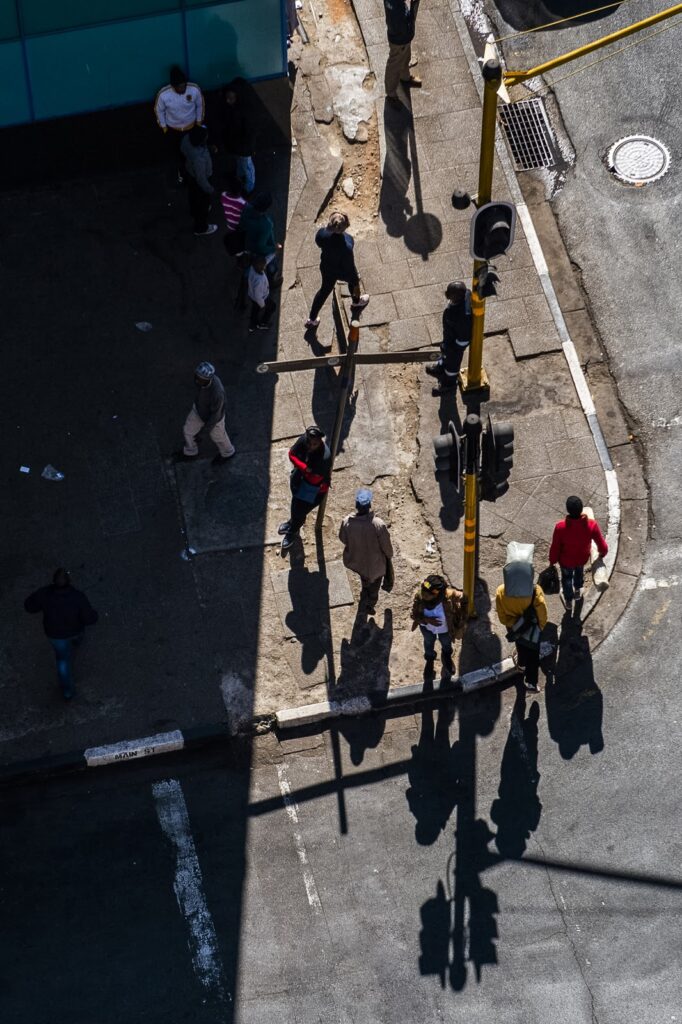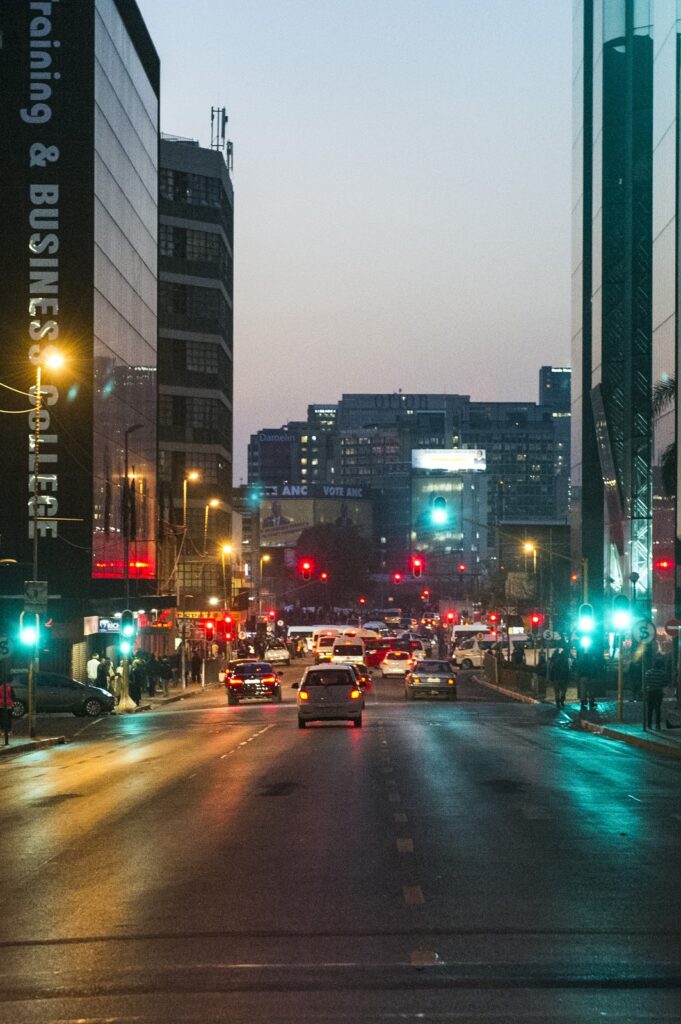The dominant gaze on the CBD and working class people is that we have to fix their problems, says academic Nicky Falkof. (Delwyn Verasamy)
The flickering of electric fences when it rains is a quintessentially Jo’burg sound, as Daily Maverick editor Branko Brkic once observed. I may be paraphrasing him, but this characterisation has stayed with me over the years.
It speaks to the city’s nervous energy, and the swirling anxiety that our systems are falling apart; that we are never quite safe in our houses — or in our minds. Even during the glory of a highveld thunderstorm, we are reminded that something is not quite right, the sparking of the electric fences needles at our psyches.
For all the physical and psychological barriers we build, every day there are many such tiny jolts as we navigate our way through being in Jo’burg. This anxiety manifests itself in particular ways, depending on where we are located in the city (geographically, and along race, class and gender lines), but we all live with it, whether from behind high walls, negotiating mobility as a woman using public transport, or through a myriad other everyday situations.
As Nicky Falkof and Cobus van Staden put it in an article about the book they edited, Anxious Jo’burg: The Inner Lives of a Global South City, “All Johannesburgers carry with us a store of anxiety, ever-present, which manifests as a kind of low-level hum underlying our daily lives.”
Falkof laughs when I ask why they chose to structure their book around anxiety. “I get asked this question so much, and the answer I want to give to people now is ‘just write what you know’,” she says. “We started from home and moved outwards,” adds Van Staden.
As academics (Falkof is an associate professor in media studies at the University of the Witwatersrand; Van Staden is a senior researcher at the South African Institute of International Affairs and a visiting researcher at Wits), their underlying reasons for using anxiety as a lens through which to read the city are multifaceted.
“I’ve always had the sense that the role of emotions politically is really, really significant and is often undermined, which, of course, is an argument that lots of feminists have been making for a really long time: that the personal is political; we need to take people’s inner lives into account when we think of how their lives manifest,” says Falkof.
The distinction between fear and anxiety is crucial to the work of the book. Fear has a specific cause, whereas anxiety is “free floating, objectless”, as psychologist Kopano Ratele defines it.
“If you think about the city in terms of fear, you end up listing all the things that people need to be afraid of. If you think about [it] in terms of anxiety, you give yourself the option to look at it from the inside out, rather than from outside in,” Falkof says.
 Anxious Joburg tries to capture the emotional landscape of the city’s inhabitants. (Delwyn Verasamy)
Anxious Joburg tries to capture the emotional landscape of the city’s inhabitants. (Delwyn Verasamy)
The different pieces in Anxious Jo’burg take us through a cross-section of residents’ inner lives, presented in a variety of forms, from traditional academic papers to diary entries, photo essays and a Q&A. There are chapters unpacking the violence after the Global Citizen concert (Van Staden), compensated relationships as a survival mechanism (Lebohang Masango), Parktown prawns and erasure (Falkof), the attempted co-option of nature in gated communities (Reguvan Raidoo) and transgender asylum seekers (B Camminga), among others. It’s tempting to list them all, to showcase the breadth on offer, but you’ll have to buy the book for that.
A photo essay by Antonia Steyn (Shifting Topographies of the Anxious City), with accompanying words by Falkof, captures the Hillbrow and Ponte Towers photographed from different locations around the city. “Depending on where one is located, their relation to each other and to the ground below can look radically different to the viewer …” Falkof writes. “It is as if the ground on which they stand is in motion and unreliable.”
Just as this photo essay highlights that there is no one stable reading of these geographical landmarks, so many of the pieces challenge prevailing stereotypes about ways of thinking about Johannesburg and its residents.
For example, Aidan Mosselson’s chapter, “Inner-city anxieties: Fear of crime, getting by and disconnected urban lives”, notes that “fear of crime is treated as a bourgeois concern”. But despite middle-class white people’s anxiety about crime, research shows it is poor black people who are most likely to fall victim to it.
Mosselson’s work, in which he interviews more than 50 residents in social or affordable housing in inner-city Jo’burg, demonstrates that the very anxiety about crime — and the ways in which Jo’burgers’ public lives are constricted by this — is not unique to the suburbs. As one respondent from Hillbrow notes: “If you feel safe, you are at home. But the minute … you’re not safe, you cannot feel at home, you say ‘no, in this place anything can happen’.”
Falkof says: “The dominant gaze on the CBD and working-class people and poor people in Africa is that we have to fix their problems. We don’t think about the nuance of what it actually feels like, which means that this hysterical white discourse about how threatened we are … ends up dominating the conversation.”
“Replicating that dynamic — where only certain people’s emotions are significant enough to be paid attention to — does have a political quotient that has a social effect. And that’s one of the things [that] needs to shift.”
This dynamic Falkof speaks of is also pertinent when considering how Johannesburg itself is characterised in scholarship produced in the Global North. In his chapter, Van Staden writes: “While anxiety is frequently expressed about the south (about population growth, or people moving north), the experience of being anxious in Global South cities receives much less attention.”
 Anxious Jo’burg is self-evidently an academic collection (published by Wits University Press). But its editors’ aim is to reach a wider audience because ‘it’s a very located thing’. (Delwyn Verasamy)
Anxious Jo’burg is self-evidently an academic collection (published by Wits University Press). But its editors’ aim is to reach a wider audience because ‘it’s a very located thing’. (Delwyn Verasamy)
One of the reasons Jo’burg is interesting to study is because the way in which the Global North projects its own fears and worries onto our city is all too often replicated in how Jo’burgers view other African cities.
“We’re hoping that is not a unique project; that work like this starts to happen more generally, across the continent,” Falkof says. “To simplify it: it’s just about talking about a global city as a real place instead of a horrifying stereotype.”
Anxious Jo’burg is self-evidently an academic collection (published by Wits University Press). But its editors’ aim is to reach a wider audience. “This is not a book that is designed to not be understood,” Falkof says firmly. “We hope that it’s going to be of interest to as many Johannesburg people as possible, because we really want it to be read in the city — it’s a very located thing.”
As a layperson, I’m not qualified to interrogate the book’s theoretical endeavours. But as a Jo’burg person, there is much that resonates, as well as new ways of thinking about the city to reflect on. Depictions of the city often fall into a binary — talking it up as a reaction to the bad press it invariably attracts; or, as Falkof notes, viewing it purely as a “problem” that must be addressed. So it was refreshing to encounter a work that neither seeks to gloss over Jo’burg’s flaws nor offers policy solutions to “fix” the city.
I had thought that reading Anxious Jo’burg may perhaps engender greater anxiety about the city and my place in it. Instead, the opposite is true — the book brings the fuzziness of objectless anxiety into sharp focus; its delineation of some of the individual roots of our collective anxiety offers a brief respite from the very condition it seeks to elucidate.
This article is published through a partnership between the Mail & Guardian and the Goethe-Institut that focuses on various aspects of innovation